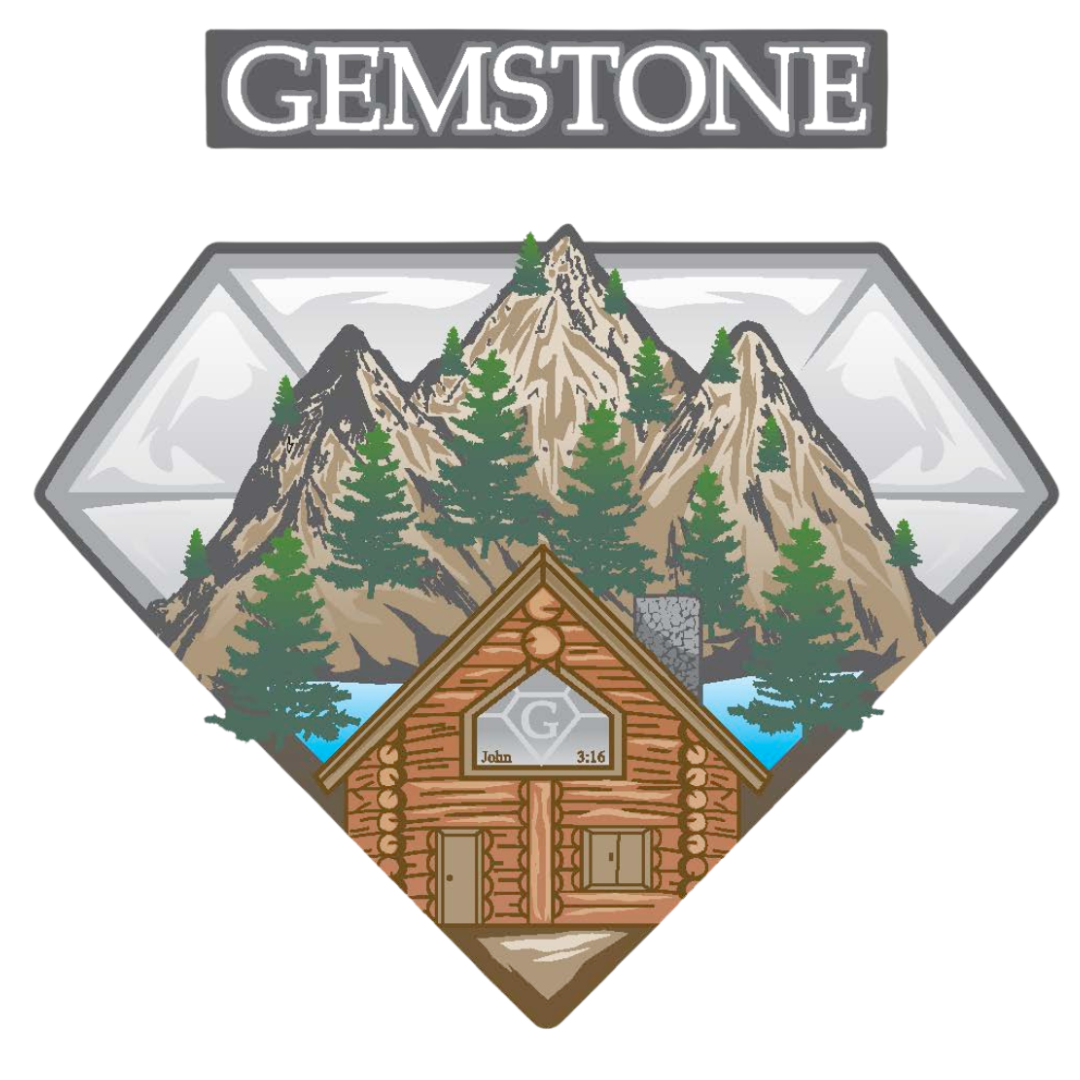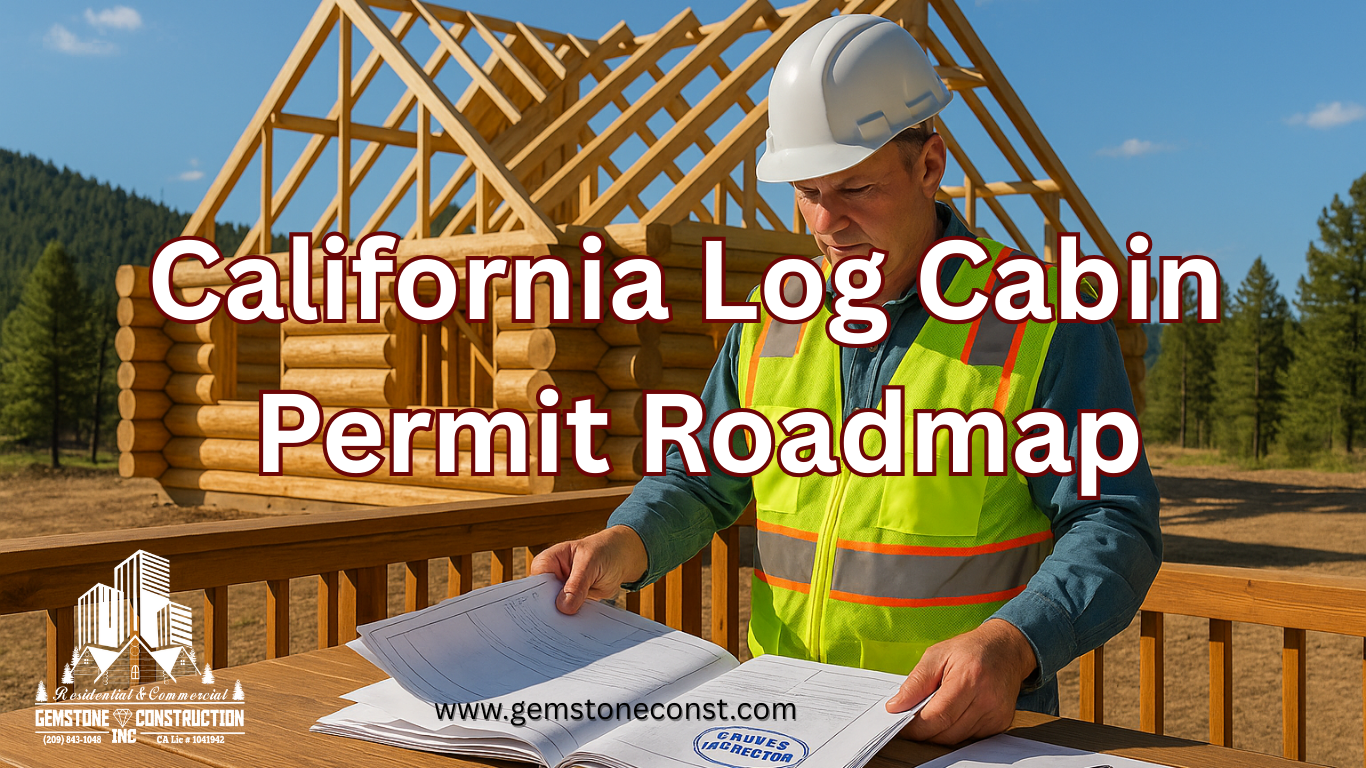GemStone Construction Blog
Permitting a Log Cabin in California: From Sketch to Final Stamp
July 12, 2025 | Sacramento, CA | USA
Two buddies bought side-by-side mountain lots last spring. By Christmas, one family had a roaring fire inside and snow piling on a brand-new metal roof. The other family still traded emails with county staff while their logs sat tarped in mud. The smoother build wasn’t luckier—just better prepared. Chasing log cabin permits California style is mostly about answering county questions before they’re asked, booking inspections in smart clumps, and treating code rules as helpful guardrails instead of hurdles.
Permits may feel like red tape, yet they protect wallets, families, and future resale. Banks refuse construction draws without green tags; insurers won’t issue full policies without final sign-offs; buyers run quickly when an online search shows unpermitted space. A clean trail also proves your walls can shrug off quakes, laugh at ember showers, and meet energy targets. If you’ve penciled in wide eaves and gravel splash trenches from our moisture guide, reviewers will spot that care right away. Our California log home builders at Gemstone Construction designed this guide to break the permit maze into bite-size, easy-to-follow steps so your plans land on the county’s “Approved” stack the first time.
Why Permits Keep Your Cabin—And Your Wallet—Safe
Permits begin with safety. California’s Residential Code calls for steel ties that lock log corners together, shear panels that stop sideways sway, and engineered spans that carry heavy timber roofs. Those details keep the house standing when the next ridge-top shaker hits. Wildland-Urban Interface rules add a second safety net: metal vent screens block embers, metal drip edges keep flames from creeping under shingles, and cement-fiber fascia won’t ignite. County plan checkers hunt for these items early; finding them saves you costly retrofits and schedule slips later on.
Money rides shotgun with safety. Construction loans pay out in gulps—called draws—only after an inspector signs each phase. Miss a rough-frame inspection and your crew sits idle while interest ticks. Home insurers follow that same inspection card before binding a policy, then shave dollars off premiums when cabins pass on the first try. Appraisers look, too; a spotless permit folder often bumps property value because it removes buyer risk.
Safety Rules Made Simple
Think of a cabin like a giant Jenga tower. Threaded rods run from the concrete slab up through the last log, so blocks never slide apart even when the earth shakes. Shear panels—plywood sheets nailed tight—stiffen corners the way a hardcover stiffens loose pages, stopping the whole stack from leaning under wind load. In fire country, Class A roofs shrug ember showers like a cast-iron skillet shrugs bacon grease, and metal gutters stay cool instead of melting and dropping burning leaves. Every one of these parts shows up on the county checklist, and none are optional if you want a green tag.
It helps to picture inspectors as safety coaches, not hall monitors. They don’t care about stain color or porch style; they focus on things that break bones or burn houses. When your drawing labels each hold-down strap and ember screen, the coach sees an athlete who already knows the playbook. Reviews fly by because the official can tick boxes instead of writing long comments. A fast first review cuts weeks off the build and saves you a pile of interest on the loan.
Dollars and Good Sense
Banks hate surprises. Snap a photo of anchor bolts stamped by an inspector and tomorrow’s draw lands before lunch. Skip that signature and framers pace around while the clock runs on payroll and interest. Insurance works the same way: no finals, no policy. When you list the cabin, buyers love seeing a fat permit binder because it proves nobody will need to tear out mystery walls later.
Clear permits also lower long-term costs you don’t see on day one. Homes with proper wildfire features often qualify for premium credits within two renewal cycles. Lenders sometimes shave interest-rate points on permanent financing when they see zero code violations. Even utility bills dip, because the same energy sheets that pass Title 24 keep winter heat and summer AC inside where they belong. A few extra hours with the code book up front can reward you every month you own the place.
Before You Buy Dirt: Zoning, Soils, and Setbacks
Permits officially start at the planning counter, but the savvy owner starts online with a zoning lookup. Parcel labels—Agricultural, Rural Residential, Timber Production—decide how wide the cabin may sprawl, how many guest houses fit, and how wide the driveway must be for fire engines. Reading those lines now is free; moving a wall five feet after submittal costs redraw fees and weeks. Discussing zoning in a coffee shop beats arguing dimensions at the county desk.
Soil science comes next. A geotech crew drills skinny test holes, hunting for solid layers and checking groundwater depth. Logs weigh more than sheetrock walls, so shallow footings pass only on firm ground. Environmental-health staff then dig perk pits that measure how fast water drains. Passing soils allow a simple gravity septic tank; failing soils demand pump-driven mounds, alarms, and budget creep. Surveyors finish by stretching tape for setbacks—twenty feet from property lines, a hundred-foot brush buffer in dense forest, and fifteen feet from creeks. Hitting all three targets early lets you order logs with confidence.
Zoning Labels in Plain Talk
Agricultural zoning gives you elbow room for a roomy cabin and plenty of land to roam, but the county can still cap the number of detached shops or studios you build unless they truly serve farm work. Because livestock is welcome, the spot where you put a barn or corral may push your cabin site a few dozen feet in one direction to keep manure away from wells and windows. Rural Residential zoning feels almost as open; most parcels let you add a second full dwelling—perfect for a future guest house or multigenerational setup—but the fire code still insists on a driveway at least fourteen feet wide for the first 150 feet and wider turnouts if the lane runs longer. Timber Production Zone (TPZ) land, by contrast, is dedicated to managed forest; you can still build a single-family log home, yet if you cut more than a few marketable trees for that postcard view, you’ll need to file a short timber-harvest plan and promise to replant. Knowing which label sits on your deed on day one saves redraw fees, keeps the project inside the rules, and stops neighbors from filing appeals when construction starts.
Zoning also shapes how you live once the cabin is finished. An Ag parcel can host a roadside farm stand selling eggs or honey, while a Rural Residential lot that bans retail sales would shut that idea down before the first customer arrives. TPZ land often rewards owners with lower annual property taxes because the county values it as working forest, but the trade-off is tighter rules: short-term rentals such as weekend Airbnb bookings are usually off-limits, and any future split of the acreage triggers a fresh timber-management plan. Reading these fine-print clauses early keeps a goat-cheese side hustle—or a dream of renting to tourists—from slamming into code walls after you’ve poured the slab. Even better, walking into the planning office already fluent in your zoning lingo shows staff you’ve done your homework, and that respect can speed every stamp, signature, and inspection down the line.
Septic and Well Basics
Perk tests run when soils are wet—usually February—to mimic worst-case drainage. Passing rates mean you file a one-page gravity layout and move on without engineered pumps. Low rates trigger pressure systems with alarms that call your phone at 2 a.m. if something fails. Wells must produce at least five gallons per minute and pass a lab purity test before plan reviewers will even open your PDF.
Booking drill rigs early avoids the spring rush. Crews often bundle well drilling and perk pits in one visit, cutting mobilization fees. If your water yield comes in low, adding storage tanks to the plan now saves a frantic scramble later. Septic and well sign-offs also impress lenders, who love seeing basic utilities locked before they wire big checks.
Drawings the County Wants to See
Most counties are married to PDFs under 100 MB with clear bookmarks. Open with a site plan that plots property lines, setback rings, driveway slope, and the gravel trench that stops rain splash—knowledge straight from our moisture guide. Next drop grading sheets that map cut-and-fill volumes plus retaining walls. Then attach structural pages: beam tables, threaded-rod lists, truss diagrams. Energy forms list window U-values, duct leakage numbers, and solar conduit ready for panels. Wildfire sheets finish the packet, calling out metal roofs, gutter guards, and spark-proof vents.
A construction schedule seals the deal. One column shows excavation dates, another framing, a third roof dry-in. Reviewers love these charts because they prove you won’t leave a half-built shell abandoned for three winters. When plan-check comments arrive, upload fixes the same day and label them “Sheet A-102 Rev-1” so staff glide straight to edits.
Structural Sheets Without Jargon
Engineers list dowel-pin spacing, notch widths, and heavy-duty steel plates at window edges. While the jargon looks fierce, it boils down to stopping logs from twisting in big winds. Truss reports guarantee ridge beams shrug off Sierra snow, and shear-panel diagrams keep fireplace stone from cracking under quake sway. If you can point to each detail on paper, reviewers rarely raise a red pen.
Adding photos or 3-D sketches next to tricky joints turns confusion into quick approval. Even a smartphone picture of a sample notch shows inspectors exactly how pieces fit. When staff understand your intent, they stamp pages with fewer notes, and you pour concrete quicker.
Wildfire Sheets That Win Fast
Wildfire pages should read like a hardware shopping list: Class A metal roofing, cement-fiber fascia, one-inch mineral-fiber eave vents, and self-closing gable shutters. Counties recognize these items by model number, so include cut sheets. That single step can slice a week of back-and-forth emails.
Don’t forget landscaping notes. A dashed line showing a five-foot gravel perimeter and a drip-irrigated native garden earns bonus smiles. It proves you plan for maintenance, not just move-in photos. Reviewers see a proactive owner and expedite stamps because your build reduces their future inspection load.
Inspections You’ll Need—and How to Sail Through Them
The first handshake with an inspector happens before a single drop of concrete leaves the chute. They’ll peer into the trench, measure rebar thickness, count anchor-bolt slots, and dig a little around the edges to confirm the footing sits at the right depth. When everything lines up, they stamp the card, and you can fill the forms without a knot in your stomach. As soon as the slab cures, call for the shear-wall visit; crews will already be nailing eight-inch grids, and the official usually enjoys seeing that momentum. Bundle the next stage by scheduling plumbing, electrical, and HVAC rough-ins on the same morning, which keeps the county from sending three trucks up the hill on three different days and saves you a trio of “hurry up and wait” moments.
Before siding hides a single fastener, the wildfire specialist stops by to tug vent screens, tap metal soffit screws, and slide a thin gauge under deck boards to confirm the gap is wide enough to shed embers but not invite critters. If a pipe sleeve looks a hair loose, a quick bead of fire-rated caulk heals the wound on the spot and proves you’re proactive, not reactive. The final inspection feels like a victory lap: smoke alarms chirp on cue, guardrails don’t wiggle, energy stickers still cling to the breaker panel, and the brush circle you trimmed yesterday frames the house like a neat haircut. Hand the inspector your permit card, press every test button while they watch, and present the punch-list you already closed; most officials appreciate seeing their checklist matched with yours. Walk in with that level of readiness and you’ll likely score the coveted green tag on the first pass, clearing the way for furniture deliveries and that hard-earned move-in celebration.
Quick Wins and Easy Mistakes
Permit runners know which clerk loves PDFs and which reviewer hates coffee rings on plans. If budget allows, hire one. If not, log into the county portal daily, answer comments within two business days, and save every reviewer’s direct number. Friendly phone calls beat fussy emails during holiday staffing gaps.
Top delays come from forgotten truss calcs, blank energy boxes, or cedar decks listed where wildfire rules demand metal. Mid-build changes hurt worse. Dreaming of a larger window once framing stands? File a revision first. Inspectors spot surprise openings fast and slap red tags even faster. Keep two full-size plan sets onsite; faded copies raise eyebrows and stretch every walk-through.
Frequently Asked Questions
How long does a rural California cabin permit really take?
Expect a marathon, not a sprint. In smaller mountain counties, a full permit run often stretches three to six months—and that’s if your packet is tidy on the first upload. Staff numbers are slim, wildfire season steals inspectors for field duty, and every winter storm pushes site visits back a few more days. Even counties with slick digital portals still need time to shuffle your plans through building, fire, and environmental‐health desks. When reviewers spot missing soil data or an unlabeled window, the clock pauses until you fix it, and each “red-line” round easily tacks on two extra weeks. Filing in January or February can trim some wait because holiday backlogs are clear and summer staffing crunches haven’t kicked in yet, but you should still pencil four months into the calendar as a realistic baseline.
Remember, the building department is only one slice of the pie. Perk tests for septic, power utility approvals, driveway fire-access checks, and separate tree-removal permits each have their own timelines—often running in parallel but sometimes stacking up. Call those offices the same week you submit your plans so every sub-clock starts together. Keep a shared spreadsheet of who needs what and when; owners who treat the process like a choreographed dance finish months ahead of neighbors who chase tasks one at a time. Bottom line: aim for early, complete submittals, line up all outside clearances up front, and plan for a season rather than a single page on the calendar.
Do power, septic, and propane each need separate permits?
Yes. A building permit covers the shell, but trenching for electric lines, drilling wells, and burying a 250-gallon propane tank all need separate permits. Bundling them saves trips and sometimes cuts fees. Utilities want load calculations; attach them early so pole work lines up with trenching. Septic permits rely on perk tests and scaled site diagrams. Propane tanks trigger Fire-Marshal review, checking setbacks and venting. Filing the trio together lets inspectors stack visits—less travel for them, quicker stamps for you.
Can I camp in an RV on-site while I build?
Most rural counties allow a self-contained RV once you pull a temporary-services permit. The trailer must tie into approved septic or a sealed holding tank, and permits usually last twelve months, renewable once. Keep the rig outside the 30-foot construction zone to dodge cranes and sawdust showers. Dumping gray water on soil or overstaying the permit racks up fines bigger than most mortgage payments. When your occupancy certificate arrives, the RV permit expires unless you convert the trailer into a legal accessory dwelling through a new review.
Do I need a separate permit to remove trees for my cabin footprint?
Often, yes. Counties in high-fire zones regulate tree removal even on private land. If you drop more than three mature trees or any heritage oak, expect a simple vegetation-management permit. The form asks for species, trunk diameter, and distance from proposed buildings. Filing it alongside your building packet lets plan checkers verify fire-access clearances and slope stability in one review cycle. Skipping the paper can stall your main permit when an inspector sees fresh stumps. Fees are small—usually under $150—and approvals land within a week if you show a replant plan or defensible-space diagram. Tackling tree paperwork early keeps both chainsaws and county stamps humming on schedule.
Ready to Build Your Dream Home?
Permits feel heavy until the road map unfolds. Check zoning first, nail down solid soils, upload crystal-clear drawings, and group inspections so crews keep swinging hammers while clerks keep stamping. County signatures then become mile markers, not hurdles. Gemstone Construction walks that route daily—drafting plans, booking tests, greeting inspectors, and pouring concrete the moment green tags hit. Reach out when you’re ready, and together we’ll raise warm timbers, seal them against rain, and hang a bright approval card on your brand-new porch.
Reference
Sonoma County Building Division. “Residential Building Permit Guide” (BPC-021). https://sonomacounty.ca.gov/PRMD/Instructions-and-Forms/BPC-021-Residential-Building-Permit-for-Projects-that-Require-Plans
About Gemstone Construction
Gemstone Construction is a premier custom home and commercial building contractor serving Northern California, including the Sacramento area. Specializing in
custom log homes,
luxury home builds,
residential metal building construction, commercial construction and
commercial metal building construction. We bring craftsmanship, attention to detail, and personalized service to every project. From designing dream homes to building cutting-edge commercial spaces, our dedicated team ensures that each build reflects our clients' unique vision and exceeds expectations. Trust Gemstone Construction to transform your ideas into reality with integrity and excellence.
Learn more about Gemstone Construction

Contact Information



